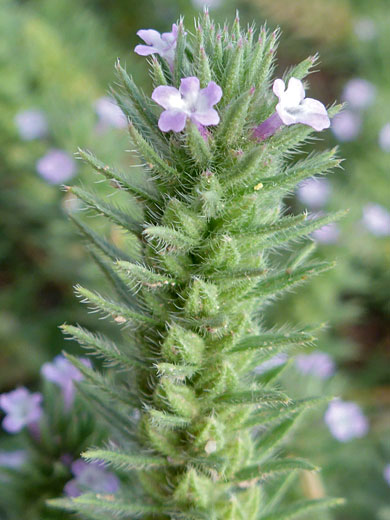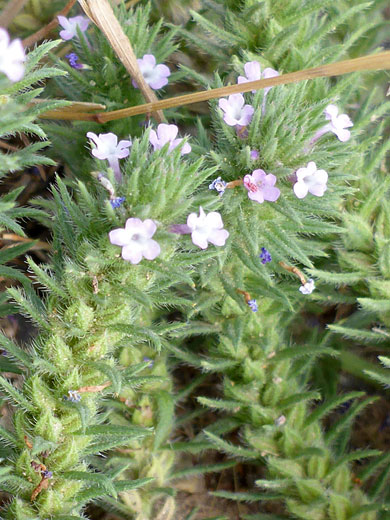
Small pink flowers and hairy green bracts - verbena bracteata at Cross Mountain Canyon, Yampa River, Colorado
Common names:
Bigbract verbena, prostrate vervain
Family:
Scientific name:
Verbena bracteata
Main flower color:
Range:
All the western states
Height:
Up to 12 inches, though stems are often prostrate
Habitat:
Riverbanks, lake margins, disturbed ground; from near sea level to 8,000 feet
Leaves:
Oblanceolate, hairy, coarsely toothed; up to 2 inches long
Season:
May to September
Leaves of verbena bracteata are relatively thick, but short, less than 2 inches in length, sparsely covered by small, spreading hairs, and symmetrically lined by large, sharp teeth or lobes. Leaves grow at the base and along the short stems. Leaf bases taper to a short, flat stalk. One plant produces several stems, which are approximately square in cross-section. Stems have a covering of quite long, white, spreading hairs.
The inflorescence is a narrow, elongated cluster (up to three per stem), up to 4 inches long at the fruiting stage. The flowers are small, less than a quarter of an inch in diameter, subtended by much larger bracts, which are linear to lanceolate in shape, and also hairy. The corolla is colored pink or light blue, opening to five rounded lobes, held at right angles to the tube. The inside of the corolla tube is white. The lobes are slightly different in size; the uppermost two are larger than the lower three.
The inflorescence is a narrow, elongated cluster (up to three per stem), up to 4 inches long at the fruiting stage. The flowers are small, less than a quarter of an inch in diameter, subtended by much larger bracts, which are linear to lanceolate in shape, and also hairy. The corolla is colored pink or light blue, opening to five rounded lobes, held at right angles to the tube. The inside of the corolla tube is white. The lobes are slightly different in size; the uppermost two are larger than the lower three.
All Contents © Copyright The American Southwest | Comments and Questions | Contribute | Site Map



